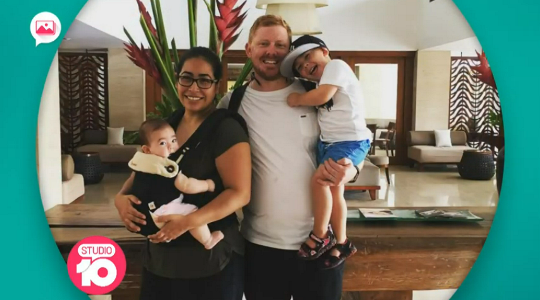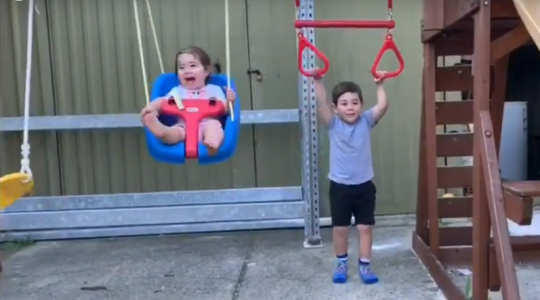Usted está aquí
Brodie's sibling cord blood therapy for cerebral palsy
If you ask Brodie how he got so strong, he has one answer, "Zoey’s blood". His little sister’s umbilical cord blood is giving him a new lease on life.
In December 2018, Brodie became one of the first children in Australia to receive sibling cord blood as treatment for cerebral palsy. He participated in the clinical trial ACTRN12616000403437 that was made possible by a partnership between the non-profit Cerebral Palsy Alliance and the family cord blood bank Cell Care. A video that displayed Brodie’s response to the therapy was released in 2019 (see below). Since then, Brodie has been featured on TV by Studio 10, and most recently Sky News in January 2022.
Cerebral palsy is the most common childhood physical disability in the world, affecting 2 in every 1,000 live births. It can affect movement, muscle tone, and coordination in a range of ways. The condition has no known cure, but it is hoped that clinical trials using stem cells from umbilical cord blood will improve patient outcomes.
According to his mother, Brenda, Brodie met all his milestones as he was growing up, but his parents noticed some irregularities in his movements, that are visible in the first half of the video. "He would be using his right hand more to move forward, and the left arm would just literally come around, but there was never any even strength."
After numerous doctor’s visits and multiple dismissals, Brodie’s family finally learned that he had experienced a stroke while in the womb. An MRI of Brodie’s brain revealed the area of the stroke, which affected his ability to control his left side. Brodie was 18 months old when he was diagnosed with left hemiplegia cerebral palsy.
In Australia, there are more than 34,000 people with cerebral palsy, which can affect both speech and movement. A team of medical researchers at Australia’s Monash University are working to better understand the mechanisms of cerebral palsy and the ways that cell therapy might help. In an interview, Prof. Graham Jenkin of Monash University explained, "The palsy side is a problem with remote motor movement, in other words movement of limbs. The brain has been damaged in some way, and those nerve tracts which go to the limbs, the legs and the arms, are affected."
On a trip to the doctor while pregnant with Brodie’s sister Zoey, his mother Brenda saw a brochure that would change their lives. It was a brochure advertising the sibling cord blood clinical trial for cerebral palsy. Prior to this, Brenda had not been aware that cord blood could be used to treat cerebral palsy. She just sat there in the clinic, stunned, looking at the brochure.

That moment in the doctor’s waiting room led to Brodie’s participation in the first clinical trial in Australia that used sibling cord blood to treat 12 children with established cerebral palsy. Brodie’s parents enrolled in Cell Care's Sibling Program that provides free cord blood banking to families that have an older sibling with cerebral palsy, a program that continues to this day. When Zoey was born, her cord blood was collected and immediately sent to Cell Care, where it was processed and stored in a laboratory that is fully licensed by the Therapeutic Goods Administration (TGA) of the Australian government, which enables it to be used in clinical trials in Australia.
Next, Brodie went to the Royal Children’s Hospital for his cord blood treatment, which was simply an infusion of the precious cord blood cells obtained from this sister Zoey. Brodie had a needle put into his arm, that was connected to a bag of Zoey’s cord blood cells, and he was given the cells the same way that you would receive a blood transfusion.
Within weeks of the transfusion, Brodie’s parents Brenda and Ben began to see notable improvements in Brodie’s condition. "Particularly with his left arm, since the cord blood treatment Brodie’s increased movement and strength in his left arm has had a significant impact on his quality of life. Prior to December, he would avoid playground apparatus requiring use of his left arm; it’s no longer the case now." said Brenda. "I’ve even noticed a difference in his intellectual ability. He is definitely brighter and more engaging since the infusion." In the second half of the video above, Brodie can be seen running across a field and kicking a soccer ball with his left leg.

The infusion of cord blood cells is believed to ameliorate the symptoms of cerebral palsy by reducing inflammation and swelling in the brain. According to Prof. Graham Jenkin of Monash University, "Cerebral Palsy, when all is said and done, is an inflammatory disease. The brain becomes inflamed for various reasons, that cause cerebral palsy, and we have shown in our preclinical studies that these cells help dampen that inflammation."
The clinical trial that Brodie enrolled in was a phase 1 study designed to investigate the safety of cord blood infusions for cerebral palsy. Although the outcomes are encouraging, it remains to be proven that Brodie’s improvements were the direct result of the cord blood treatment. A follow up phase 2 clinical trial is being planned in Australia that will cover a larger group of participants in order to gauge the efficacy and further evaluate the safety of sibling cord blood therapy.
Meanwhile, Prof. Jenkin and colleagues at Monash Health are running the clinical trial ACTRN12619001637134, the world’s first trial attempting to prevent cerebral palsy by treating very preterm babies born before 28 weeks gestation. Nearly half of children who develop cerebral palsy are born prematurely. To help combat this statistic, the new trial hopes to reduce the severity of cerebral palsy by giving the premature babies cells obtained from their own umbilical cord blood as soon as possible after birth. Midwives often argue that babies benefit from methods of cord clamping that allow some of the blood in the umbilical cord to return to the baby. However, that approach is not possible when a baby is in distress and born preterm. In premature births, doctors must focus first on rescuing the baby. However, if that premie’s cord blood can be rescued as well, and returned to the baby, it may help the development of the newborn brain.
Brodie’s parents believe that the cord blood therapy has meant that he can do everything they once feared he wouldn’t.



